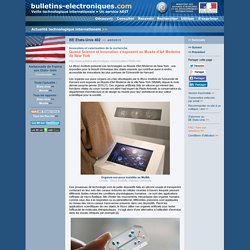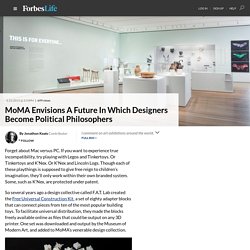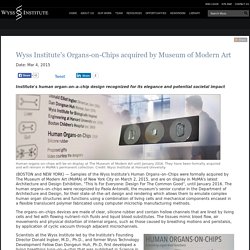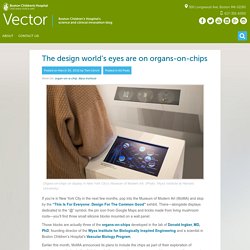

2015/05/04 > BE Etats-Unis 402 > Quand Science et Innovation s'exposent au Musée d'Art Moderne de New York. Innovation et valorisation de la rechercheQuand Science et Innovation s'exposent au Musée d'Art Moderne de New York Le Wyss Institute présente ses technologies au Musée d'Art Moderne de New York : une exposition pour la beauté intrinsèque des objets exposés qui contribue aussi à rendre accessible les innovations les plus pointues de l'Université de Harvard.

Les organes-sur-puce (organs-on-chip) développés par le Wyss Institute de l'université de Harvard sont exposés au Musée d'Art Moderne de la ville New-York (MoMA) depuis le mois dernier jusqu'en janvier 2016 [1]. Ces organes artificiels faits en silicone qui miment des fonctions vitales du corps humain ont attiré l'oeil expert de Paola Antonelli, la conservatrice du département d'architecture et de design du musée pour leur esthétisme et leur valeur scientifique pour la société.
Tag: Wyss Institute. MoMA Envisions A Future In Which Designers Become Political Philosophers - ForbesLife. Forget about Mac versus PC.

If you want to experience true incompatibility, try playing with Legos and Tinkertoys. Or Tinkertoys and K’Nex. Or K’Nex and Lincoln Logs. Though each of these playthings is supposed to give free reign to children’s imagination, they’ll only work within their own branded system. Some, such as K’Nex, are protected under patent. So several years ago a design collective called F.A.T. The Free Universal Construction Kit. It’s now on view as part of a new exhibition of “design experiments for the common good”.
While Antonelli’s ambition for design isn’t supported by all of her selections (including the eminently practical Kikkoman bottle), objects such as the lung-on-a-chip show that designers are already encroaching on philosophical territory. Massimo Banzi, David Cuartielles, Tom Igoe, Gianluca Martino, David Mellis, Giorgio Olivero. The Free Universal Construction Kit even more overtly operates in the realm of ideas. It’s just play, of course. Wyss Institute's Organs-on-Chips acquired by Museum of Modern Art. Date: Mar 4, 2015 Institute's human organ–on–a–chip design recognized for its elegance and potential societal impact Human organs–on–chips will be on display at The Museum of Modern Art until January 2016.

They have been formally acquired and will remain in MoMA's permanent collection. Credit: Wyss Institute at Harvard University (BOSTON and NEW YORK) — Samples of the Wyss Institute's Human Organs–on–Chips were formally acquired by The Museum of Modern Art (MoMA) of New York City on March 2, 2015, and are on display in MoMA's latest Architecture and Design Exhibition, "This Is For Everyone: Design For The Common Good", until January 2016. The organs–on–chips devices are made of clear, silicone rubber and contain hollow channels that are lined by living cells and fed with flowing nutrient–rich fluids and liquid blood substitutes.
The organs–on–chips exhibit also includes a one and a half minute video that explains how the design of the chips allows them to emulate organ–level functions. Organs-on-chips meld art and science. If you’re in New York City in the next few months, pop into the Museum of Modern Art (MoMA) and stop by the “This Is For Everyone: Design For The Common Good” exhibit.

There—alongside displays dedicated to the “@” symbol, the pin icon from Google Maps and bricks made from living mushroom roots—you’ll find three small silicone blocks mounted on a wall panel. Those blocks are actually three of the organs-on-chips developed in the lab of Donald Ingber, MD, PhD, founding director of the Wyss Institute for Biologically Inspired Engineering and a scientist in Boston Children’s Hospital’s Vascular Biology Program.
Earlier this month, MoMA announced its plans to include the chips as part of their exploration of contemporary design in the digital age. In the museum’s eyes, organs-on-chips are more than a way to model disease in a complex, living system—they’re also art. MoMA isn’t the only design icon paying attention to the chips.